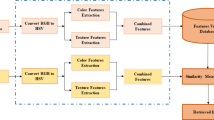Abstract
This study proposed a new image retrieval technique in which the existing radon transform that was used for image retrieval is reinforced with noise invariance. For this, a radon transform was performed on an inquiry image which had been preprocessed to extract vector values and then the vector values were arranged depending on size to extract a second feature vector. After clustering and normalizing the levels of vector values based on the second feature vector, the feature vector was created. For a simulation on the image retrieval technique using the clustering based on rearranged radon transform, diverse images were used in this experiment. For performance analysis, the system proposed was compared with the retrieval system using a rearrangement hough transform based on voting number. As a result, the proposed image retrieval technique was more robust to geometric transforms such as rotated and scaled in the retrieval technique using the general radon transform and standard hough transform, and it had recall enhanced to 0.05 and precision enhanced to 0.04 in comparison with the rearrangement hough transform based on voting number.














Similar content being viewed by others
References
Aggarwal N, Karl WC (2006) Line Detection in Images Through Regularized Hough Transform. IEEE Trans Image Process 15(3):582–591
Brown RG, Hann CE, Chase JG (2010) Vision-based 3D surface motion capture for the DIET breast cancer screening system. Comput Appl Technol 72–78
Capi G (2010) A vision-based approach for intelligent robot navigation. Intell Syst Technol Appl 97–107
Chatterjee A, Ray O, Chatterjee A, Rakshit A (2011) Development of a real-life EKF based SLAM system for mobile robots employing vision sensing. Expert Syst Appl 8266–8274
Cho B-H, Jung S-H (2008) Efficient correction of a rotated object using radon transform. JKorean Inst Inf Sci Eng (KIISE) 14(3):291–295
Dorado A, Saavedra G, Sola-Pikabea J, Martinez-Corral M (2015) Integral imaging monitors with an enlarged viewing angle. J Inf Commun Convergence Eng 13(2):132–138
Duda RO, Hart PE (1972) Use of the Hough transformation to detect lines and curves in pictures. Commun ACM 15(1):11–15
Fang Y (2010) Fusion-layer-based machine vision for intelligent transportation systems. MIT Thesis
Fishbain B, Mehrubeoglu M (2010) Guest editorial of the special issue on real-time vision-based motion analysis and intelligent transportation systems. Real-Time Image Process 213–214
Gonzalez RC, Richard E (1992) Woods, digital image processing. Addison Wesley
Gonzalez RC, Woods RE (2008) Digital image processing. Prentice Hall, Third Edition
Hart PE (2009) How the Hough transform was invented. IEEE Signal Process Mag 18–22
Hough P (1959) Machine analysis of bubble chamber pictures. Int Conf High Energy Accel Instrum 554–556
Hough P (1962) Method and means for recognizing complex patterns. U S Patent 3(069):654
Kim J (2000) Development of MPEG-7 technology. National IT Industry Promotion Agency, 37–38
Li W-C, Tsai D-M (2011) Defect inspection in low-contrast LCD images using Hough Transform-Based Nonstationary Line Detection. IEEE Trans Ind Inform 7(1):136–147
Luengo Hendriks CL et al (2005) The generalized Radon transform: Sampling, accuracy and memory considerations. Pattern Recogn 38(12):2494–2505
Martiney JA, Rodriguez U, Nechyba M (2003) An automated implementation of eamlets to classify frames of triggered lightning. FCRAR 2003:1–6
Otsu N (1979) A threshold selection method from gray-level histogram. IEEE Trans Syst Man Cybernetics SMC-9:62–66
Park SJ, Ahmad MB, Seung-Hak R, Han SJ, Park JA (2004) Image corner detection using radon transform. LNCS 3046:948–955
Patel M, Lal S, Kavanagh D, Rossiter P (2010) Fatigue detection using computer vision. Electron Telecommun 56(4):457–461
Press WH (2006) Discrete Radon transform has an exact, fast inverse and generalizes to operations other than sums along lines. PNAS 103(51):19249–19254
Radon J (1917) Üer die Bestimmung von Funktionen durch ihre Integralwerte lӓngs gewisser Mannigfalt- igkeiten. Berichte Sӓq chsische Akad Wissenschaften, Leipzig, Math Phys Klasse 69:262–277
Rosenfeld A (1969) Picture processing by computer. Academic, San Diego
Thuc ND, Duc DA (2004) The Hough transform - a radon - like transform. Int Conf Electron Inf Commun 274–275
Won J (1998) Two-dimensional filtering through the radon transform. J Korean Soc Remote Sensign 14(1):17–36
Acknowledgments
This study was supported by research funds from Chosun University, 2014.
Author information
Authors and Affiliations
Corresponding author
Rights and permissions
About this article
Cite this article
An, Y., Lee, J. & Park, J. Image retrieval technique using the clustering based on rearranged radon transform. Multimed Tools Appl 75, 12983–12997 (2016). https://doi.org/10.1007/s11042-016-3527-7
Received:
Revised:
Accepted:
Published:
Issue Date:
DOI: https://doi.org/10.1007/s11042-016-3527-7




